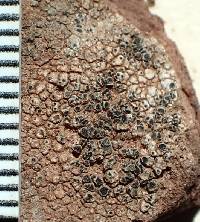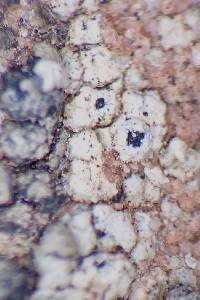
Consortium of Lichen Herbaria
- building a Global Consortium of Bryophytes and Lichens as keystones of cryptobiotic communities -
- Home
- Search
- Images
- Species Checklists
- US States: O-Z >
- US National Parks
- Central America
- South America
- US National Parks
- Southern Subpolar Region
|
|
|
|
Family: Ramalinaceae
|
Nash, T.H., Ryan, B.D., Gries, C., Bungartz, F., (eds.) 2004. Lichen Flora of the Greater Sonoran Desert Region. Vol 2. Thallus: crustose, up to 3 cm across, up to 0.5 mm thick, effuse, rimose-areolate to areolate-subsquamulose areoles: irregularly +round, usually verrucose or composed of squamulose-like adjacent parts but sometimes only with scattered small verrucose warts, 0.3 to 1.5 mm across, incised at margin with divisions 0.15-0.6 mm wide surface: grayish green with concolorous edges, darker green when wet, slightly shiny, epruinose cortex: paraplectenchymatous, hyphae with lumina 2-7 µm long, containing some scattered algae, overall 10-25 µm thick, covered with an epinecral layer 5-15 µm thick, without crystals medulla: weakly developed due to the relative thick algal layer, without crystals; algal layer: up to 400 µm thick, continuous, weakly paraplectenchymatous throughout; algae: 8-15 µm in diam. Apothecia: numerous, becoming crowded, erumpent, appressed to sessile, sometimes stipitate disc: dark reddish brown, not discolored when wet, plane, margin: thalline, concolorous with thallus, entire to sometimes becoming crenate, with a narrow, densely pruinose inner rim, persistent, becoming thinner but not excluded amphithecium: paraplectenchymatous in lower part with lumina of 2-5 µm wide, with an epinecral layer c. 5 µm parathecium: weakly developed, reddish brown in outer part with a narrow rim of strongly conglutinated cells 10 µm wide, widened toward the outer rim and c. 50 µm wide epihymenium: hyaline to pale reddish brown, in a gelatinous matrix, with granules around the paraphyses tips hymenium: hyaline, 65-80 µm tall; paraphyses simple, moderately coherent, mid-hymenium cells 9-12 x 1.5-2 µm in diam., widened towards the top, the apices capitate and 3-5 µm wide; hypothecium: +hyaline, with intricate hyphae, 30-40 µm thick asci: clavate, Bacidia-type, 40-50 x 10-17 µm, 8-spored ascospores: hyaline, 1-septate, oblong-ellipsoid, (9-)10-14(-20) x 45(-6) µm Pycnidia: immersed, +round, 150 µm in diam., pale brownish around the ostiole, hyaline below; ostiole: 50-80 µm; conidiogenous cells: elongate, c. 10 x 2 µm conidia: filiform, strongly curved, sometimes almost forming a circle, 15-22 x 0.8 µm Spot tests: all negative Secondary metabolites: not detected. Substrate and ecology: on sandstone outcrops, in open shrubland in an area with scattered trees; associated with some Caloplaca sp., Peltula euploca and Catapyrenium s.l., Phaeophyscia hirsuta and Staurothele sp. World and Sonoran distribution: found only in NW and central Arizona. Note: Lecania arizonica resembles L. turicensis; however, its thallus is different in several aspects, including color (grayish green, greener when wet) and morphology (areoles verruculose, incised at margin) as well as anatomy (with a distinct cortex). Furthermore, its apothecial margin is entire, relative thick, and not excluded, and the new species occurs on siliceous rather than calcareous rocks. Because of its habitus, Lecania arizonica is also confusable with L. inundata, a species also known from the Sonora region, but the latter species has somewhat bigger ascospores, a more areolate-papillate thallus with a different color and apothecia, that are only rarely weakly pruinose. Halecania australis, that is found in the same habitat as L. arizonica, differs in having Catillaria-type asci, clavate to ovoid ascospores with a halo-like perispore, bacilliform conidia, somewhat smaller apothecia with epruinose discs, and somewhat smaller areoles with a browner upper surface, and it lacks a cortex and epinecral layer. |
|
|
|
Powered by Symbiota






















